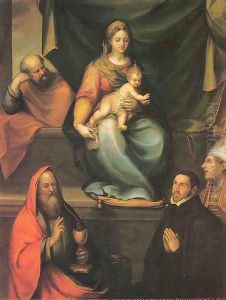Blas del Prado Paintings
Blas del Prado, although not as widely recognized today as some of his contemporaries, was an important painter during the Spanish Renaissance. The exact year of his birth remains uncertain, but he was active during the 16th century, a period marked by the flourishing of the arts in Spain, influenced by both the Italian Renaissance and the Northern Renaissance. Prado's life and career were primarily rooted in Spain, but like many artists of his time, his works reflect a blend of local and international artistic trends. He died in 1599, leaving behind a legacy that, though not as extensively documented as that of some of his peers, contributes significantly to our understanding of the period.
Blas del Prado is known for his religious paintings, portraits, and still lifes, a genre that was gaining popularity in Europe at the time. His art demonstrates a keen attention to detail and a vibrant use of color, which were characteristic of the Spanish Renaissance. One of his most notable contributions to the art world was his incorporation of botanical and floral motifs into his works, which not only showcased his technical skill but also his observant nature and the growing interest in the natural world during the Renaissance.
Despite the scarcity of records concerning his life, it is believed that Prado received commissions from notable figures of the Spanish court and the Catholic Church, indicating his reputation and the high esteem in which he was held. Furthermore, some sources suggest that he may have traveled to the Americas, specifically to the Viceroyalty of Peru, which was a rare and adventurous undertaking for artists of his time. This experience might have influenced his palette and introduced novel elements into his work, reflecting the diverse flora and fauna encountered in the New World.
Prado's legacy is preserved in various Spanish institutions and collections, where his works continue to be studied and admired. His contributions to the Spanish Renaissance encapsulate the era's artistic innovations, the cross-cultural exchanges that enriched European art, and the evolving tastes of the period. While detailed records of his life and the full extent of his oeuvre may be limited, Blas del Prado remains a figure of interest for art historians and enthusiasts exploring the depths of Spanish Renaissance art.
